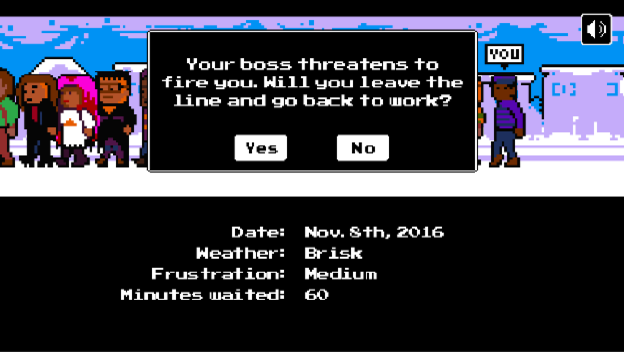Oh man, I remember Oregon Trail ! I played that on my first Macintosh when I was 8 years old! This new refitted version is nothing like the game I remember, though. The New York Times, in light of this year’s 2016 Election, published The Voter Suppression Trail for their Op-Doc series. Made by GOP Arcade, this game makes a very clear statement on how voter suppression works and how it can affect presidential elections. It’s playable for free here , should you choose investigate the game in more detail. As a side note, I had to open it up in an alternate browser so if it doesn’t work for you right away try another browser.
The beginning of the game is quite transparent as to how things will turn out as your choices of voters are: a white programmer from California, a Latina nurse from Texas, or a black salesman from Wisconsin. The white programmer, as you might guess, simply goes to the polling station and votes. For the Latina nurse, things start a little differently. The line-up is long and the weather blistering. Half an hour of waiting in line and a card comes up telling you that “your son has dysentery. Will you leave the line and pick him up from school?” If you decide to be completely horrible (the situations get progressively worse as time goes on) and continue saying no, you will finally get to the polling station. There, election “observers” will try to attack you with their “insults and angry rhetoric.” It’s easy to navigate away from them, but your next obstacle comes quickly after. You are required to have photo ID and you either have to go get it, cast a provisional ballot, or give up entirely.
For the black salesman from Wisconsin, it isn’t being a jerk that’s on the line. Instead, your boss gets upset with you, threatens to fire you, and cancels your next three shifts. This may not seem realistic to some of you, but I can tell you from experience that the retail industry has absolutely no qualms threatening or actually firing you for extremely arbitrary reasons. The rest happens exactly like the Latino nurse, should you sacrifice your job to vote.
On one hand, this is a great way to repurpose a much loved game into something educational. Games can educate in a way that no other medium can, by letting the player personally experience whatever you need them to. In this case, voter suppression. In the US, the 2002 Help America Vote Act required that all new voters in the federal elections had registered by mail and produce government issued photo ID at the polling station. The requirements of registration and photo ID vary from state to state, and herein lies the problem. Some states simply require you to register via mail and produce the card at the polling station, others require both registration and photo ID. Even the conditions of what photo ID you can use vary between the states. As The Voter Suppression Trail illustrates, voting can be quite the affair if you don’t have the right identification etc. depending on what state you’re in.

On the other hand, there are quite a few folks who think the Help America Vote Act is perfectly justified and the difficulty of voting for certain people is based on the fear of voter fraud. They claim it’s common sense and perfectly easy to acquire any of the registration or photo ID requirements. This point of view colors The Voter Suppression Trail as trying to enforce a specific opinion. In some ways, violating the original Oregon Trail game by using it as a means of propaganda.
Personally, I’m on the side of education. The game may not be able to explain the full extent of problems the Help America Vote Act has caused, but it’s a start. It certainly got me researching the topic, and I don’t even live in the US. Though it did make me appreciate how the Canadian polls are run a lot more. The Voter Suppression Trail is, in my opinion, the perfect way to get the message across and encourage people to demand change.
